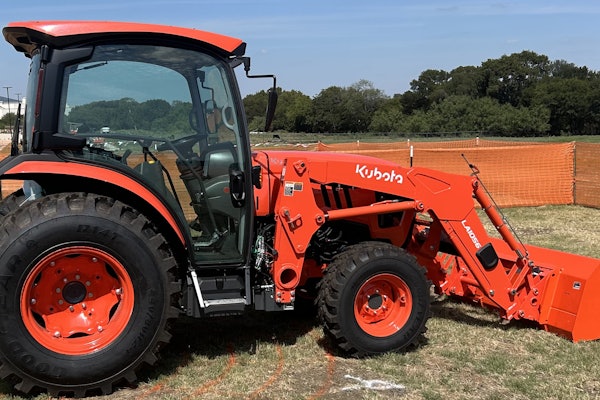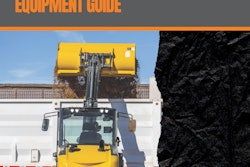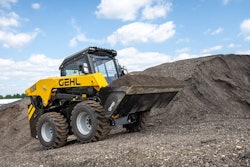Track pads are an essential component on many pavers and milling machines and are bought frequently as aftermarket add-ons for excavators, cranes and even dozers. When buying or spec’ing track pads you face the choice of either rubber pads or polyurethane. The differences are substantial; and as with most things, if you choose the wrong product for your machine or application, you’ll lose money and/or suffer from increased downtime or reduced performance. Here is a comparison of the performance characteristics of each and some advice on how to make the right choice.
Polyurethane’s hardness gives it the ability to withstand abrasion.
Hardness
Polyurethane is harder than rubber. Hardness in these materials is determined by what’s known as a Shore A Durometer test. Most rubber compounds get a 70 to 80 Shore A Durometer rating. Polyurethanes typically test in the range of 90 to 96 Shore A Durometer, although you can get a “soft” polyurethane pad (for better traction) that’s rated at an 85 Shore A Durometer.
Advantage: polyurethane
Durability
Depending on the application, polyurethane pads will last two to three times longer than conventional rubber pads. “We provide both rubber and polyurethane track pads to give our customers a choice of pads to fit their applications,” says Barry Stoughton, president of BLS Enterprises.
“Typically poly is going to be more durable as far as abrasion resistance,” says Scott Holcomb, product line manager, Superior Tire & Rubber, which also sells both kinds. “There are some applications where if you have polyurethane, you’re not going to get the tractive effort you need and spin your tracks and wear the polyurethane quicker. But frankly, in most of the applications we deal with, that’s not the case.”
One exception to poly’s dominance in durability is claimed by a company called Evertire, which brought a rubber formula and pad design to the North American market five years ago that it says meets or exceeds the durability of poly pads.*
According to Nick Abeyta, sales representative for Evertire, Everpads use a special rubber compound and pad design that takes into consideration the dynamic stresses of the undercarriage. “We build that into the grain of the rubber and the shape of the pad to work with the machine, not against it.” The result is a much better wear life than conventional rubber pads. Evertire also says rubber’s softness can give it a resilience to certain types of impact or injury.
Advantage: polyurethane, with exceptions noted
Traction
Since rubber is softer than polyurethane, it has better grip. “Rubber was always meant for better traction,” says Abeyta. “Sometimes you’re working in a wet or inclined environment where you need all the traction you can get. You don’t want the machine to slide.” Whether or not traction is important depends on your machine, applications and operating conditions. Wet, smooth or sloped surfaces may require better traction depending on the machine, its weight, speed and what it’s pushing or carrying.
Advantage: rubber, although a softer poly pad will also provide good traction
The softness of rubber pads makes them the best choice when traction is a primary concern.
Cost
“A lot of customers think poly is more expensive and better and rubber is just less expensive. And that’s not the case,” says Holcomb. Pad for pad, on initial purchase price conventional rubber is about 25 percent less expensive than polyurethane. But once you factor in total lifecycle and the labor involved in replacing pads, poly often gives you better value over time, he says.
“A lot of times rubber is used because it’s economical,” Holcomb says. “Some contractors just replace their pads at the end of a season. But others are getting more sophisticated and realize that polyurethane pads will save them a lot of money over a three-year span.” Again, one exception to the price formula is Evertire, which says its premium rubber is priced and will perform comparably with polyurethane.
Advantage: On high-utilization machines, the extra money you pay for poly pads or premium rubber will usually more than pay for itself over time. But for low-hour machines, temporary jobs or occasional use, conventional rubber’s lower cost may be justified.
Machine type
Milling machines are the most abrasive application for track pads. Polyurethane pads have just about taken over this market, but Evertire claims success in it as well. With pavers, curb-and-gutter machines, excavators, trenchers and dozers, protecting the surface they travel on from damage is the primary consideration. Here rubber and poly afford roughly equal benefit. Traction can be an issue with trenchers, excavators and dozers since they travel over a variety of surfaces. Conventional rubber can be the most economical choice here for low-hour utilization rates, but for high-utilization machines you may want to consider upgrading to a more durable product.
Advantage: polyurethane or premium rubber for milling, a toss up for pavers, dozers and excavators with exceptions noted above
Chemical resistance
Rubber is susceptible to softening and degradation when exposed to oil and diesel fuel. Strong cleaning agents can cause polyurethane to break down or cause the bond between the polyurethane and the metal grouser to weaken. Good preventive maintenance and cleaning practices are the solution here. When washing machines, make sure you rinse oil, hydraulic fluid and cleaning compounds off the track pads and park the machine on a dry spot free from any residue.
Advantage: tie
Pad design
There are three basic styles of pad: clip on, bolt on and bonded. Clip-on styles work best for short-term use, says Joanna Carr, a track pad specialist with Superior Tire & Rubber. They can be put on and taken off quickly as conditions warrant. Bolt-on pads can be used in any application and come in rubber or poly. With bolt-on designs you don’t have to buy (or pay for shipping) the steel shoe every time you replace pads. Bonded pads are glued to a shoe that attaches to the track chain. Bonded pads are used for the heaviest applications.
Advantage: Choose the pad design appropriate to the application as noted above.
Editor’s note: The scope of this article is intended as a general discussion and it is beyond our capabilities to verify or disprove claims made by any manufacturer. If you want more specific information about the durability or lifecycle of any product we recommend asking your vendor to put you in touch with other contractors who have used their product in similar conditions and applications.









